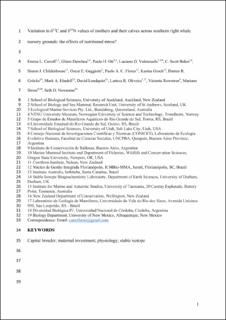| dc.contributor.author | Carroll, Emma L. | |
| dc.contributor.author | Dunshea, Glenn | |
| dc.contributor.author | Ott, Paulo H. | |
| dc.contributor.author | Valenzuela, Luciano O. | |
| dc.contributor.author | Baker, C. S. | |
| dc.contributor.author | Childerhouse, Simon J. | |
| dc.contributor.author | Gaggiotti, Oscar | |
| dc.contributor.author | Flores, Paulo A. C. | |
| dc.contributor.author | Groch, Katia Regina | |
| dc.contributor.author | Gröcke, Darren R. | |
| dc.contributor.author | Hindell, Mark A. | |
| dc.contributor.author | Lundquist, David | |
| dc.contributor.author | Oliveira, Larrissa R. | |
| dc.contributor.author | Rowntree, Victoria | |
| dc.contributor.author | Sironi, Mariano | |
| dc.contributor.author | Newsome, Seth D. | |
| dc.date.accessioned | 2022-01-31T10:04:52Z | |
| dc.date.available | 2022-01-31T10:04:52Z | |
| dc.date.created | 2021-08-16T15:23:23Z | |
| dc.date.issued | 2021 | |
| dc.identifier.issn | 0824-0469 | |
| dc.identifier.uri | https://hdl.handle.net/11250/2975894 | |
| dc.description.abstract | Southern right whales (SRW) are capital breeders that use stored energy reserves to sustain themselves and their calves on nursery areas. With successful calving events declining in some SRW populations, it has been hypothesized that nutritional stress in adult females causes reproductive failure or death of calves shortly after birth. Here we compared offsets in carbon and nitrogen isotope values of mothers and their offspring (Δ13Ccalf-cow and Δ15Ncalf-cow) among three SRW populations. SRW from Aotearoa New Zealand, with high population growth rates and body conditions scores, have negative Δ13Ccalf-cow suggesting calves are utilizing 13C-depleted lipid carbon in milk to fuel the synthesis of nonessential amino acids used to build new tissues and rapidly grow. In contrast, a significantly positive Δ13Ccalf-cow offset previously reported for SRW from Argentina during a mass die-off event was hypothesized to be due to calves consuming milk with low lipid content. Patterns in Δ15Ncalf-cow were more difficult to interpret and highlight the complexity in nitrogen transfer between mother and offspring. When combined with similar data collected from Brazil and during a low mortality year in Argentina, we hypothesize this approach provides a way to retrospectively compare nutritional condition of breeding adult female SRW across nursery areas. | en_US |
| dc.language.iso | eng | en_US |
| dc.publisher | Wiley | en_US |
| dc.title | Variation in d13C and d15N values of mothers and their calves across southern right whale nursery grounds: the effects of nutritional stress? | en_US |
| dc.type | Peer reviewed | en_US |
| dc.type | Journal article | en_US |
| dc.description.version | acceptedVersion | en_US |
| dc.rights.holder | Locked until 13.9.2022 due to copyright restrictions. This is the peer reviewed version of the an article which has been published in final form at [http://dx.doi.org/10.1111/mms.12871]. This article may be used for non-commercial purposes in accordance with Wiley Terms and Conditions for Use of Self-Archived Versions. | en_US |
| dc.source.journal | Marine mammal science | en_US |
| dc.identifier.doi | 10.1111/mms.12871 | |
| dc.identifier.cristin | 1926398 | |
| cristin.ispublished | false | |
| cristin.fulltext | postprint | |
| cristin.qualitycode | 1 | |
